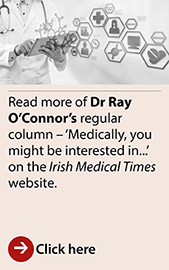Dr Ray O’Connor , 2025-05-20 07:30:00
Dr Ray O’Connor takes a look at the latest clinical articles on stroke – the second leading cause of death globally
Stroke is an acute, focal neurological deficit with no other explanation than a cerebrovascular cause. Common symptoms include hemiparesis, dysarthria, sensory deficits, aphasia, and visual deficits.
The Lancet journal recently published the proceedings of a seminar on stroke.1 The seminar covered the diagnosis, acute management, and secondary prevention of ischaemic stroke and intracerebral haemorrhage, with a focus on recent developments and future perspectives. The main points of the paper are as follows. Globally, with only little variation, ischaemic strokes constitute between 60–70 per cent of all strokes and result from an acute arterial occlusion.

Dr Ray O’Connor
Historically, transient ischaemic attack (TIA) was diagnosed when complete resolution of symptoms happened within 24 hours, although nowadays the presence of a restricted diffusion lesion on MRI despite clinical recovery qualifies for a diagnosis of ischaemic stroke (irrespective of the duration of symptoms).
This qualification implies that a TIA is in fact a minor ischaemic stroke. Stroke affects up to one in five people during their lifetime in some high-income countries, and up to almost one in two in low-income countries. Globally, it is the second leading cause of death.
Clinically, the disease is characterised by sudden neurological deficits. Vascular aetiologies contribute to the most common causes of ischaemic stroke, including large artery disease, cardio-embolism, and small vessel disease. Small vessel disease is also the most frequent cause of intracerebral haemorrhage, followed by macrovascular causes.
For acute ischaemic stroke, multimodal CT or MRI reveal infarct core, ischaemic penumbra, and site of vascular occlusion. For intracerebral haemorrhage, neuroimaging identifies early radiological markers of haematoma expansion and probable underlying cause.
For intravenous thrombolysis in ischaemic stroke, tenecteplase is now a safe and effective alternative to alteplase. In patients with strokes caused by large vessel occlusion, the indications for endovascular thrombectomy have been extended to include larger core infarcts and basilar artery occlusion, and the treatment time window has increased to up to 24 hours from stroke onset.
Regarding intracerebral haemorrhage, prompt delivery of bundled care consisting of immediate anticoagulation reversal, simultaneous blood pressure lowering, and prespecified stroke unit protocols can improve clinical outcomes. Guided by underlying stroke mechanisms, secondary prevention encompasses pharmacological, vascular, or endovascular interventions and lifestyle modifications. The full paper is well worth a read for anyone dealing with general medical patients.
 The next paper takes a global view of stroke over the last 30 years.2 Among non-communicable disorders (NCDs), stroke remains the second leading cause of death and the third leading cause of death and disability combined (as expressed by disability-adjusted life-years lost—DALYs) in the world. The study aimed to estimate global, regional and national burden of stroke and its risk factors from 1990 to 2021.
The next paper takes a global view of stroke over the last 30 years.2 Among non-communicable disorders (NCDs), stroke remains the second leading cause of death and the third leading cause of death and disability combined (as expressed by disability-adjusted life-years lost—DALYs) in the world. The study aimed to estimate global, regional and national burden of stroke and its risk factors from 1990 to 2021.
Findings presented in this paper were derived mainly from the Global Burden of Disease 2021 Study on stroke. The estimated global cost of stroke is over US$890 billion (0.66 per cent of the global GDP). From 1990 to 2021, the burden increased substantially (70.0 per cent increase in incident strokes, 44.0 per cent deaths from stroke, 86.0 per cent prevalent strokes, and 32 per cent DALYs), with the bulk of the global stroke burden (87.0 per cent of deaths and 89.0 per cent of DALYs) residing in lower-income and lower-middle-income countries (LMICs). Stroke attributable to metabolic risks constituted 69.0 per cent of all strokes, environmental risks constituted 37.0 per cent, and behavioural risks constituted 35.0 per cent.
Approximately one-third of acute ischemic strokes with an identifiable vessel occlusion are caused by medium vessel occlusion (MeVO), that is, nonlarge vessel occlusions that are potentially amenable to endovascular treatment (EVT). This topic is the subject of another review.3 Management of patients with MeVO is challenging in many ways: detecting MeVOs can be difficult and therefore some remain undiagnosed.
While the clinical course of MeVO stroke with medical management, including intravenous thrombolysis, is by no means, benign, it is more favourable compared with large vessel occlusion. At the same time, EVT complication rates are higher, and thus, the marginal benefit of EVT beyond best medical management is expected to be smaller and more challenging to detect.
Several randomized controlled trials are currently underway to investigate whether and to what degree patients with MeVO may benefit from EVT and will soon provide robust data for evidence-based MeVO EVT decision-making. In this review, the authors discuss different ways of defining MeVOs, strategies to optimize MeVO detection on imaging, and considerations for EVT decision-making in the setting of MeVO stroke.
What about the role of Atrial Fibrillation (AFib) in stroke? This is discussed in a recent comprehensive review.4 AF and stroke remain a major cause of morbidity and mortality. The two conditions share common co-morbidities and risk factors. AF-related strokes are associated with worse clinical outcomes and higher mortality compared to non-AF-related. Early detection of AF is vital for prevention.
While various scores have been developed to predict AF in such a high-risk group, they are yet to incorporated into clinical guidelines. Novel markers and predictors of AF including coronary and intracranial arterial calcification have also been studied. There are also ongoing debates on the management of acute stroke in patients with AF, and those who experienced breakthrough stroke while on oral anticoagulants. The paper provides an overview of the complex interplay between AF and stroke, as well as the treatment and secondary prevention of stroke in AF.
Sleep disturbances are implicated as risk factors of both stroke and dementia. However, whether these associations are causal and whether treatment of sleep disorders could reduce stroke and dementia risk remain uncertain.
The aim of this observational and Mendelian randomised study5 was to evaluate associations and ascertain causal relationships between sleep characteristics and stroke/dementia risk and MRI markers of small vessel disease (SVD).
The authors analysed UK Biobank participants with self-reported sleep measurements, including sleep duration, insomnia, napping, daytime dozing, and snoring. The findings were that among 502,383 participants (mean age, 56.5 years; 54.4 per cent female), there were 7,668 cases of all-cause dementia and 10,334 strokes.
In longitudinal analyses, after controlling for cardiovascular risk factors, participants with insomnia, daytime napping, and dozing were associated with increased risk of any stroke (HR 1.05, 1.09 and 1.19 respectively). Almost all sleep measures were associated with dementia risk (all p < 0.001, except insomnia). Cross-sectional analyses identified associations between napping, snoring, and MRI markers of SVD (all p < 0.001). MR analyses supported a causal link between genetically predicted insomnia and increased stroke risk (OR 1.31), but not with dementia or SVD markers.
The authors’ conclusion was that multiple sleep measures predicted future risk of stroke and dementia, but these associations were attenuated after controlling for cardiovascular risk factors and were absent in MR analyses for Alzheimer disease. This suggests possible confounding or reverse causation, implying caution before proposing sleep disorder modifications for dementia treatment.
References:
- Hilkens N et al. Stroke. Lancet 2024; 403: 2820–36. Published Online May 14, 2024 https://doi.org/10.1016/S0140-6736(24)00642-1
- Feigin V et al. World Stroke Organization: Global Stroke Fact Sheet 2025. International Journal of Stroke 2025, Vol. 20(2) 132–144. https://doi.org/10.1177/17474930241308142
- Ospel J et al. Endovascular Treatment of Medium Vessel Occlusion Stroke. Stroke. 2024;55:769–778. doi: 10.1161/STROKEAHA.123.036942
- Elsheikh S et al. Atrial fibrillation and stroke: State-of-the-art and future directions. Curr Probl Cardiol 49 (2024) 102181. https://doi.org/10.1016/j.cpcardiol.2023.102181
- Guo C et al. Sleep Characteristics and Risk of Stroke and Dementia; An Observational and Mendelian Randomization Study. Neurology 2024;102:e209141. doi:10.1212/WNL.0000000000209141


